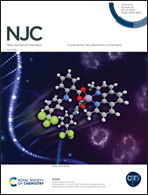Theoretical studies on substrate-controlled selectivity of nickel-catalyzed hydroalkylation of 1,3-dienes†
Abstract
The mechanism of nickel-catalyzed selective hydroalkylation of 2-aryl-1,3-dienes has been studied using density functional theory (DFT) calculations. A reaction pathway was suggested, which involves the deprotonation of the amide substrate, ligand coordination with the nickel centre, ligand-to-ligand hydrogen transfer (LLHT) and finally nucleophilic attack. Analysis of the calculated energy profiles shows that the rate-determining step is the LLHT process. For the LLHT step, hydrogen transferring to the least sterically hindered C4 position of 1,3-diene to form a metal-π-allyl intermediate needs the lowest activation barrier because the allylic-Ni intermediate is the most stable. The allyl group binding to the metal centre in an η3 fashion also promotes the following nucleophilic attack owing to the electron-withdrawing capability of the metal. The subsequent nucleophilic attack leads to regio-divergent products with a different substrate. For a linear amide substrate, nucleophiles selectively attack the least hindered terminus carbon of the π-allyl–Ni species to form 1,4-addition products due to the steric effect. However, for a cyclic imide substrate, nucleophiles selectively attack the nonterminal carbon leading to 3,4-selective products, which is supposed to be a result of the electron-withdrawing capability of heteroatoms on the cyclic imide. Furthermore, on combining a cyclic imide substrate and a chiral ligand, a stereoselective 3,4-addition product is obtained due to steric effects. All the calculation results are in agreement with the experimental results. An alternative pathway which includes the step of hydrometalation from the nickel-hydride complex to the diene and the reductive elimination is ruled out due to the calculated high-energy barrier that cannot be achieved under the experimental conditions.



 Please wait while we load your content...
Please wait while we load your content...